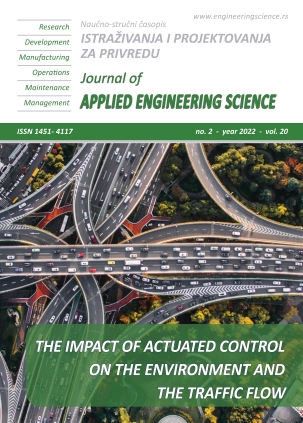MECHANICAL PROPERTIES CHARACTERIZATION OF RAT-TRAP BOND BRICK MASONRY
Abstract
Brick masonry is one of the most popular building technique for residential buildings, especially in the developing countries. The two most common types of bonds adopted in brick masonry are English and Flemish. However, rat-trap bond is gaining popularity in South Asian countries like India, Pakistan, and Sri Lanka. It is a type of masonry bond in which shiners and rowlocks are laid on the edges such that the shiners have 1/3rd cavity between them resulting in cost reduction, dead load reduction, faster construction and thermal insulation, etc. This paper presents the results of an experimental investigation of rat-trap bond masonry for mechanical characterization. Four prism specimens were tested for compressive strength, four for diagonal strength, and twelve triplets were tested for shear strength. It was found that the mechanical properties of rat-trap masonry lie within the range of English bond masonry in Pakistan as determined by various researchers. In addition, the compressive strength and elastic modulus were found within the specified range of Building Code of Pakistan, while the shear modulus showed higher values.
References
Gilbile D, Dhopte P, Talegaonkar S, Khandait H, Harpal PD (2020) . Study on Low Cost Housing with Roof Top Rainwater Harvesting. International Journal of Innovative Research in Technology, 6(11):526–30.
Chaudhary HR (2017). Cost Optimization Using Alternative Construction Techniques For Low Height Buildings. International Journal of Innovative Research and Advanced Studies. 4(7):159–63.
Dizhur D, Ingham J. (2015). Seismic Improvement of Loadbearing Unreinforced Masonry Cavity Walls. BRANZ Report ER3. DOI:10.13140/RG.2.1.2335.0482
Bureau of Indian Standards. National building code of India 2016. Vol. 1. Bureau of Indian Standards. 78–82 p.
Humqadam SCRP, Humqadam - School Construction and Rehabilitation Program, from https://humqadam.pk/ accessed on 2019 Sep 11.
Medvedev P, Pugach E, Gaidukov P. (2019). Technological Application Features of Brickwork Bonding Types. IOP Conference Series: Materials Science and Engineering. 471(2):22–35.
Santhakumar AR,, A.Sivakumar SA. (2015). Validation of Rat-trap bond for cost effective housing. 9th Canadian Masonry Symposium.
Nauman Azhar M, Ali Qureshi L. (2020). Experimental study of structural behaviour of Chinese bond brick masonry: A new trend of durable & economical construction in Pakistan. Journal of King Saud University - Engineering Sciences. DOI:10.1016/j.jksues.2020.09.013
Nadarajan M, Kirubakaran V. (2016). A comparison on simulation and validation of rural residential buildings using low cost technologies. International Journal of Applied Engineering Research. 11(1):484–91.
Khan A, Thaheem MJ. (2018). Comparison of performance of rat-trap brick bond with conventional brick bond. In: 1ST Int. conference on high performance energy efficient buildings and homes-Lahore. p. 255–62.
Jayasinghe C, Lakmali HDD, Rohitha MP. (2008). Comparative Performance of Masonry Bond Patterns. In: Annual transactions of the Institution of Engineers Sri Lanka. p. 38–46.
ASTM C67-07a, (2007). Standard test methods for sampling and testing brick and structural clay tile. ASTM West Conshohocken, PA, USA;
Building code of Pakistan, (2007). Seismic Provision, SP-2007. Ministry of housing and works, Government of Pakistan.
ASTM. C109/C109M-11, (2011). Standard test method for compressive strength of hydraulic cement mortars. ASTM West Conshohocken, PA, USA;
ASTM. C1314 - 09, (2015). Standard Test Method for Compressive Strength of Masonry Prisms. ASTM West Conshohocken, PA, USA;
European Committee for Standardization (CEN). EN 1052-3, (2007). Methods of test for masonry–Part 3: Determination of initial shear strength. European Committee for Standardization Brussels, Belgium.
ASTM. E519-02, (2005). Standard Test Method for Diagonal Tension (Shear) in Masonry Assemblages. ASTM West Conshohocken, PA, USA.
ASTM. E 447-97, (2017). Standard Test Methods for Compressive Strength of Laboratory Constructed Masonry Prisms. ASTM West Conshohocken, PA, USA.
Ashraf M. (2010). Development of Cost-effective and Efficient Retrofitting Technique for Masonry Buildings in Pakistan. PhD Dissertation. University of Engineering and Technology Peshawar, Pakistan. http://eprints.hec.gov.pk/9628/>
Javed M. (2009). Seismic Risk Assessment of Unreinforced Brick Masonry Buildings System of Northern Pakistan. PhD Dissertation. University of Engineering & Technology Peshawar, Pakistan.
Shahzada K, Khan AN, Elnashai AS, Ashraf M, Javed M, Naseer A, et al. (2012). Experimental seismic performance evaluation of unreinforced brick masonry buildings. Earthquake Spectra. 28(3):1269–90.
Ali Q, Naeem A. (2007). Seismic resistance evaluation of unreinforced masonry buildings. Journal of Earthquake Engineering. 11(2):133–46.
Naseer A. (2009). Performance Behavior of Confined Brick Masonry Buildings under Seismic Demand. PhD Dissertation. University of Engineering & Technology Peshawar, Pakistan.
Sajid HU, Ashraf M, Ali Q, Sajid SH. (2018). Effects of vertical stresses and flanges on seismic behavior of unreinforced brick masonry. Engineering Structures; 155 394–409. DOI:10.1016/j.engstruct.2017.11.013

